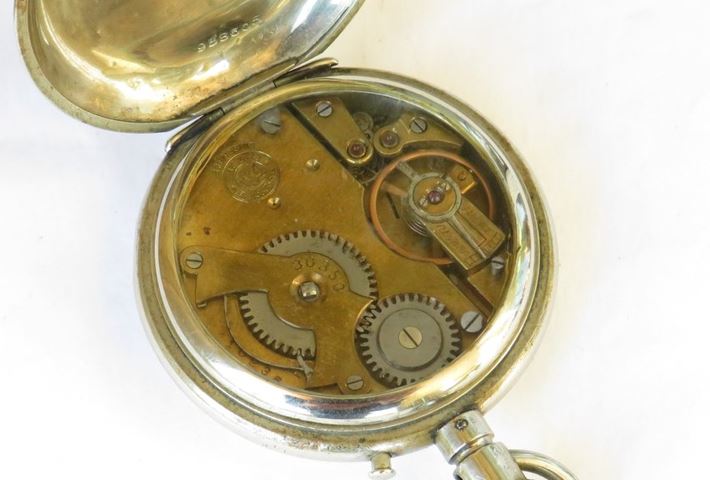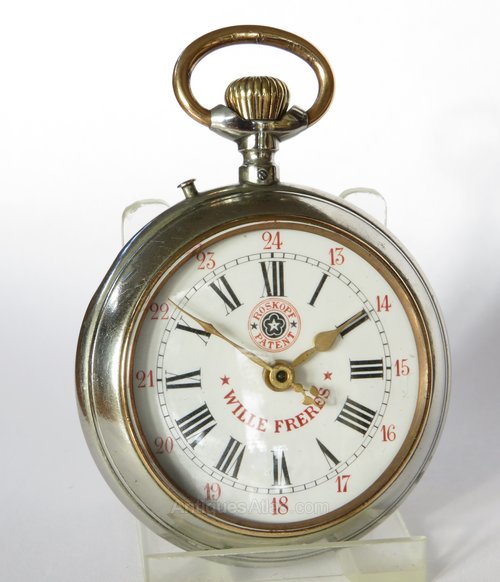Last updated on May 12, 2024
The Roskopf or pin-pallet escapements are extremely simple watch movements. The movement design is named after its developer, the German-Swiss watchmaker Georg Friedrich Roskopf, and is characterised by an extremely low-cost production. The Roskopf escapement consisted of an anchor made of brass and two metal pins, which functioned simultaneously as fork pallets and as banking or limiting pins. These watches, although cheap and reliable are not considered high-quality timepieces. It is unlikely, that I will add one of these timepieces to my collection. However, I have enjoyed researching the history of Roskopf and his creation.
Early life
Georg Frédéric Roskopf was born on the 15th of March 1813 in the municipality of Niederweiler, Germany. He was the son of a butcher, Johann Georg Roskopf, and his wife, Maria Elisabeth. In 1829 he moved to La Chaux de Fonds in Switzerland. There he began an apprenticeship as a sales clerk in the firm of F. Mairet & Sandoz, selling watchmakers’ materials. In 1834, he began a watchmaking apprenticeship with the watchmaker J. Biber. However, the apprenticeship only lasted a year and Roskopf left and married a wealthy widow, Françoise Lorimier, who already had two children. His new wife’s money allowed Roskopf to set up in business as a watchmaker in his own right at Leopold Robert Street, La Chaux de Fonds.
Initially, Roskopf started out as an établisseur, buying watch components and assembling them for retail sale. However, by 1850, the firm was struggling and Roskopf sold the business. He accepted a position as a manager in the Swiss branch of B.J. Guttmann, a German company that assembled watches for sale primarily in America. After ten years at B.J. Guttmann, Roskopf left to pursue his dream of making a watch that was affordable to ordinary people. At the time, watches were really only accessible to the middle and upper classes. He dreamed of producing a watch with a retail price of about twenty francs, which was about a week’s wages for a labourer at the time.
Roskopf movement
By 1867, Roskopf had designed a simplified watch movement. It had several features that deviated from the standard lever movement of the time. The escapement he chose was the pin-pallet lever invented by the French watchmaker L. Perron in Besançon in 1798. This was a cheap form of the lever escapement, in which the escapement pallets were made from steel pins instead of jewels. Roskopf’s goal was to reduce the number of components in the watch in order to reduce costs and simplify the manufacturing process. He deviated from standard practice by removing the centre wheel so that the third wheel was driven directly from the mainspring barrel. Many of Roskopf’s watches omitted the second hand as another cost-saving measure.
Initially, Roskopf intended to make his watch cases from brass. However, this proved to be impractical so he decided to use German silver or argentan, an alloy mainly consisting of copper, nickel and zinc. This material was inexpensive, easy to work with and had a ‘silver’ appearance. Another cost-saving innovation was to make the dials from printed cardboard rather than enamelled copper.
The reduction of the number of components in the movement made the manufacturing and assembly process relatively simple. The concept wasn’t well received by the industry in Switzerland and there was much resistance. Roskopf found it difficult to find a manufacturer willing to supply him with ebauches. Eventually, Roskopf employed the Malleray Watch Company to produce the movement ébauches, dials and cases. These were then assembled to produce the finished watch. Roskopf called his watch “montre proletaire“, the labourer’s watch.
Affordable timepiece
The watch was simple, rugged and reliable. Most importantly, it was affordable and available to the masses. The downside of the movement was its general lack of jewelled bearings. This meant that it was subject to wear and tear from friction over time. Ultimately, when a Roskopf movement began to lose accuracy, it was often more economical to buy a replacement than to have it serviced. There were some manufacturers who went to the effort of jewelling the Roskopf movements, most notably Oris.
In order to promote his new invention, Roskopf exhibited at the Paris Universal Exhibition in 1868. Unexpectedly, he won a Bronze Medal, which did much to publicise his pin-pallet movement. It is common to see Roskopf watch case backs adorned with the medallions he won at international exhibitions over the years. Roskopf patented his invention in France, Belgium and the United States. However, he was unable to do so in Switzerland because that country did not establish a Patent Office until 1888. This resulted in numerous other manufacturers adopting his invention to produce similar watches. These are typically marked as ‘System Roskopf’.
Wille Freres
In 1872, Roskopf’s wife, Maria Elisabeth, died. Roskopf sold the house in La Chaux de Fonds and handed over his business to Charles Léon Schmid and the brothers C. and E. Wille, his wife’s grandsons. Although the Wille brothers were only his step grandsons, Roskopf felt he should repay his wife’s generous investment in his idea and company. The new company was named Wille Freres. In 1873, Roskopf remarried a school teacher 24 years younger than himself and they lived for a short time in Cernier, where Roskopf acquired Swiss citizenship in 1874. Later they moved to Berne, where Roskopf died on 14th April 1889.
In the twentieth century, the Roskopf brand continued to flourish. It supplied the British and US markets and became the most-exported Swiss watch with millions of timepieces being exported each year by the start of the 70s. Like many other Swiss made brands the Roskopf company failed to survive the quartz crisis of the 1970s and 1980s.
Typical features of the Roskopf movement
1. Escapement on a platform normally using a pin lever design but possible with a lever or cylinder escapement;
2. No centre wheel but a large barrel;
3. Motion work to hands directly from the barrel arbour;
4. Philippe free spring with no stop work;
5. Button wind but without the time setting mechanism. The hands were set by finger pressure.
Related content
Roskopf at the British Museum
Georges Frederic Roskopf at Wikipedia


Interesting post, but it sounds like Roskopf movements and watches should generally be avoided as a collector?
Hi Ivan, I am sure that there are Roskopf collectors out there, but generally they would be something I would avoid. Here is a guide on what to look for when collecting antique watches. I would advise on collecting any antique watches with seven jewels or less, as in the long run you will pay more for antique watch servicing. Thanks for taking the time to comment, Jason